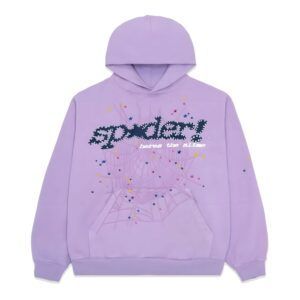The Genesis of Sp5der: A Disruptive Entrance into Streetwear
Sp5der, the avant-garde streetwear https://kingsp5derhoodie.com/ brand that emerged seemingly out of nowhere, has rapidly ascended to the top tiers of urban fashion. Spearheaded by rapper Young Thug, the brand was born from a fusion of music, cultural rebellion, and distinctive aesthetics. With its eccentric spider web graphics, daring colorways, and unapologetic street energy, Sp5der carved its identity in a space crowded with competitors like Supreme, Vlone, and Off-White.
While many brands build slowly over time, Sp5der’s rise was meteoric, thanks to the influential clout of its founder and the brand’s organic connection to Atlanta’s thriving hip-hop scene. It was more than fashion—it was a visual extension of Young Thug’s fearless persona.
Design Language: Bold, Unconventional, Iconic
What makes Sp5der’s apparel instantly recognizable is its bold, graffiti-style motifs, such as spider webs, glitter print logos, rhinestones, and oversized silhouettes. The brand’s commitment to standing out, not fitting in, is evident in each collection. This visual intensity resonates with a generation that prioritizes expression over conformity.
From vibrant color palettes—neon greens, blazing pinks, acid yellows—to punk-inspired fonts and chaotic textures, Sp5der garments feel like wearable rebellion. The core philosophy: disrupt streetwear norms and reject minimalism.
Every hoodie, t-shirt, and pair of sweatpants is a statement piece, defying traditional rules of design and embracing a chaotic beauty that mirrors the energy of trap music and street culture.
Celebrity Endorsements and Cultural Influence
No modern streetwear brand reaches legendary status without strategic celebrity support, and Sp5der mastered this early. Worn by cultural titans like Lil Baby, Gunna, Travis Scott, and Drake, Sp5der quickly became synonymous with the upper echelon of hip-hop royalty.
The brand’s popularity skyrocketed when viral social media posts and paparazzi shots captured top-tier celebrities donning Sp5der gear. The message was clear: Sp5der isn’t just fashion—it’s a lifestyle badge for those shaping today’s culture.
This celebrity association fuels demand, making each drop a high-stakes affair. Pieces sell out in minutes, and secondary market prices often double or triple, reinforcing Sp5der’s status as a hypebeast essential.
Limited Drops and the Scarcity Effect
Sp5der understands the mechanics of streetwear hype: scarcity sells. Much like Supreme’s business model, Sp5der employs limited releases and unpredictable drop schedules to create a frantic, high-demand atmosphere.
Each collection feels exclusive, and owning a piece becomes a status symbol. The brand leverages this with strategic collaborations, pop-up shops, and online drops that sell out within seconds. This method fuels FOMO (fear of missing out), pushing Sp5der’s allure beyond just fashion into the realm of cultural obsession.
The Influence of Music and Trap Culture
At the core of Sp5der’s DNA is trap music—gritty, raw, and unapologetically expressive. Young Thug didn’t just create a brand; he built a visual soundtrack to match the sound of Atlanta. Sp5der’s designs reflect the energy of the genre: loud, experimental, rebellious.
By aligning itself so closely with music, Sp5der became a walking mixtape, worn by artists who create the very soundtrack that drives youth culture. This connection enhances the brand’s authenticity and ensures it remains deeply rooted in the culture it represents.
Collaborations and Expansion of Influence
Sp5der’s evolution isn’t isolated to its core designs. The brand has expanded strategically, teasing collaborations with visual artists, skaters, and even high-fashion players. These partnerships hint at a global vision, aiming to merge the rawness of streetwear with the sophistication of art and high fashion.
Each collaboration acts as a cultural bridge, pulling in new audiences while reinforcing Sp5der’s underground roots. With potential crossovers in sneaker design, music merchandising, and art installations, the brand is poised to become a cross-industry powerhouse.
Marketing Strategy: Organic, Influencer-Driven, and Social First
Unlike traditional brands reliant on polished advertising campaigns, Sp5der’s marketing thrives on organic visibility. It builds hype through:
Instagram drip reveals
TikTok influencer endorsements
Behind-the-scenes photos from concerts and parties
Unboxing videos from key streetwear YouTubers
This strategy places the brand directly in the hands of the culture shapers, rather than through mainstream media. Each post, reel, and tag becomes part of an evolving narrative: Sp5der is where the culture lives.
Target Audience and Identity Building
Sp5der doesn’t chase traditional demographics. Its appeal lies in its connection to Gen Z and late Millennials—a crowd that thrives on individualism, rebellion, and digital validation. Sp5der garments become armor for the digital battlefield, turning each wearer into a standout figure.
The brand has created a tribal identity, one where being part of the Sp5der movement means more than fashion—it means being in-the-know, ahead of the curve, and unapologetically bold.
Sustainability and Streetwear: A Future-Focused Direction
As the fashion industry faces increasing pressure to adopt eco-conscious practices, Sp5der has started engaging with sustainability narratives. While it isn’t yet a green pioneer, the brand is rumored to be exploring recycled fabrics, ethical sourcing, and slow fashion principles to align with modern expectations.
This strategic evolution will position Sp5der not just as an aesthetic leader but also as a forward-thinking player capable of adapting to changing industry norms.
Conclusion: Sp5der’s Place in the Streetwear Pantheon
In under a decade, Sp5der transformed from a music-inspired concept into a streetwear empire. With its unique blend of bold design, cultural authenticity, celebrity clout, and scarcity-driven hype, the brand didn’t just follow trends—it defined them.
As Sp5der continues to expand into new markets, cross-industry collaborations, and potentially sustainable fashion, its dominance in the streetwear space looks not only stable but inevitable.
